Potassium Silicate Market
Potassium Silicate Market Size and Share Forecast Outlook 2025 to 2035
Potassium silicate market is projected to grow from USD 420.0 million in 2025 to USD 660.0 million by 2035, at a CAGR of 4.6%. Crop Protection & Foliar Feed will dominate with a 47.0% market share, while liquid will lead the form segment with a 72.0% share.
Potassium Silicate Market Forecast and Outlook 2025 to 2035
The global potassium silicate market is valued at USD 420.0 million in 2025. The market is slated to reach USD 660.0 million by 2035. This records an absolute increase of USD 240.0 million over the forecast period. The total growth amounts to 57.1%. The market forecast shows expansion at a compound annual growth rate (CAGR) of 4.6% between 2025 and 2035.
The overall market size is expected to grow by approximately 1.57X during the same period. Growth is supported by increasing demand for crop protection applications. Growing agricultural productivity requirements drive expansion. Rising preference for sustainable farming solutions supports market development. Expanding industrial coating applications create opportunities across potassium silicate usage.
Quick Stats for Potassium Silicate Market
- Potassium Silicate Market Value (2025): USD 420.0 million
- Potassium Silicate Market Forecast Value (2035): USD 660.0 million
- Potassium Silicate Market Forecast CAGR: 4.6%
- Leading Application in Potassium Silicate Market: Crop protection & foliar feed (47.0%)
- Key Growth Regions in Potassium Silicate Market: North America, Europe, and Asia-Pacific
- Key Players in Potassium Silicate Market: PQ Silicates, BASF, PotashCorp, PQ Corporation, AkzoNobel, Nouryon, Novaphene, Evonik, Nippon Chemical, Sibelco
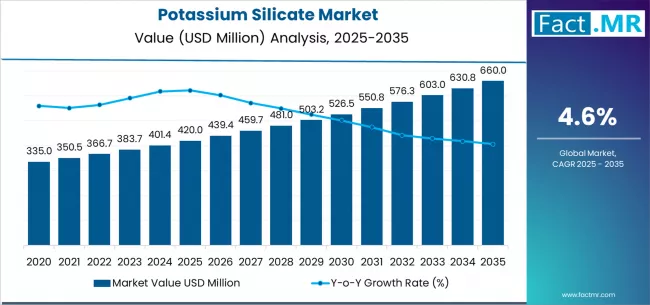
The potassium silicate market represents a specialized segment of the global agricultural and industrial chemicals industry. The market shows steady technological advancement. Consistent demand exists across agricultural input channels. Industrial application channels drive growth. Market dynamics are influenced by changing agricultural requirements toward sustainable crop protection. Growing interest in organic farming management shapes development. Expanding partnerships between chemical manufacturers drive growth. Agricultural operators in developed economies show increased adoption. Emerging economies demonstrate growing demand patterns. Traditional chemical methods continue evolving. Agricultural specialists seek proven crop protection alternatives. Enhanced yield benefits attract farming users. Reliable chemical characteristics remain essential requirements.
Consumer behavior in the potassium silicate market reflects broader sustainable agriculture trends. Efficient treatment systems provide functional benefits. Effective systems deliver crop protection advantages. The market benefits from growing popularity of organic farming solutions. These systems are recognized for sophisticated agricultural integration. Technical approach to crop treatment gains acceptance. The versatility of potassium silicate supports multiple applications. Standalone chemical devices serve specific needs. Integrated agricultural system components expand market reach. Multiple farming applications drive demand growth. Industrial segments show increased adoption patterns.
Regional adoption patterns vary significantly across global markets. North American markets show strong preference for standardized potassium silicate implementations. European markets demonstrate similar standardization trends. Asian markets show increasing adoption of sustainable agricultural solutions. Conventional chemical systems remain popular in developing regions. The agricultural landscape continues evolving with sophisticated products. Quality-controlled potassium silicate products gain traction in mainstream applications. Agricultural applications reflect farmer willingness to invest in improvements. Proven crop protection system enhancements attract investment. Performance-oriented features drive adoption decisions.
The competitive environment features established agricultural chemical companies. Specialized potassium silicate solution providers focus on unique capabilities. Advanced processing methods drive differentiation. Production efficiency remains critical for market participants. Product development optimization continues as key factor. Raw material costs create ongoing challenges. Quality standardization requirements fluctuate regularly. Distribution strategies emphasize multi-channel approaches. Traditional agricultural supply chains combine with direct partnerships. Technical service platforms expand market reach. Supply distribution agreements strengthen customer relationships.
Market consolidation trends indicate acquisition strategies by larger manufacturers. Agricultural chemical companies acquire specialized potassium silicate operations. Product portfolio diversification drives acquisition activity. Access to specialized agricultural system segments motivates purchases. Private label development has gained momentum. Agricultural companies seek differentiation opportunities. Competitive pricing structures remain important considerations.
Specialized potassium silicate variants emerge in the market. High-concentration options reflect changing application priorities. Liquid formulation options create new market opportunities. Innovative agricultural system developers benefit from emerging trends. Manufacturing automation enables consistent production scaling. Quality control improvements maintain traditional performance characteristics. Agricultural managers expect established performance from crop protection brands.
Between 2025 and 2030, the potassium silicate market projects expansion from USD 420.0 million to USD 540.0 million. This results in a value increase of USD 120.0 million. The increase represents 50.0% of the total forecast growth for the decade. This development phase will be shaped by increasing adoption of sustainable agricultural systems. Rising demand for crop protection drives growth. Foliar feeding applications gain market acceptance.
Growing emphasis on agricultural productivity features supports expansion. Enhanced treatment characteristics attract users. Agricultural operators expand sustainable capabilities. Growing demand for specialized potassium silicate implementations continues. Advanced formulation options gain popularity. Agricultural offerings across farming segments increase.
Potassium Silicate Market Key Takeaways
| Metric | Value |
|---|---|
| Estimated Value (2025E) | USD 420.0 million |
| Forecast Value (2035F) | USD 660.0 million |
| Forecast CAGR (2025-2035) | 4.6% |
From 2030 to 2035, the market is forecast to grow from USD 540.0 million to USD 660.0 million. This adds another USD 120.0 million. The addition constitutes 50.0% of the overall ten-year expansion. This period is expected to be characterized by expansion of advanced agricultural technologies. Integration of innovative treatment solutions continues. Development of specialized potassium silicate implementations occurs.
Enhanced sustainability profiles gain importance. Extended application capabilities attract users. Growing adoption of precision agriculture will drive demand. Potassium silicate with superior treatment characteristics gains acceptance. Compatibility with sustainable farming technologies across agricultural operations expands.
Between 2020 and 2025, the potassium silicate market experienced solid growth. Increasing demand for sustainable agriculture drove development. Growing recognition of potassium silicate as essential crop protection component supported expansion. Yield enhancement programs across agricultural applications gained momentum. Industrial applications showed growth. The market developed as farmers recognized potential benefits.
Potassium silicate solutions provide functional advantages. Crop protection benefits enable convenient treatment protocols. Technological advancement in agricultural systems began development. Sustainability-critical applications emphasize importance of maintaining performance. Consistency in diverse agricultural environments becomes critical.
Why is the Potassium Silicate Market Growing?
Market expansion is supported by increasing demand for sustainable agricultural solutions. Farming requirements drive growth. Crop protection needs create demand. Corresponding need for foliar feeding provides superior plant benefits. Quality advantages enable enhanced crop outcomes. Extended compatibility across various agricultural applications drives growth. Industrial applications show expansion. Modern agricultural operators focus on implementing proven crop protection technologies.
Sustainability specialists seek effective plant support. Minimized chemical complexity appeals to users. Consistent performance throughout complex farming configurations attracts adoption. Diverse agricultural environments require reliable solutions. Potassium silicate delivers exceptional crop efficacy against traditional alternatives. Advanced farming integration capabilities support modern protocols. Essential components for contemporary agricultural operations gain acceptance.
Growing emphasis on sustainable farming drives demand for organic agricultural adoption. Potassium silicate supports large-scale farming requirements. Improved crop outcomes attract users. Advanced treatment systems gain acceptance. Farmer preference for products combines effective crop support with proven performance. Sustainability benefits create opportunities for innovative implementations. Rising influence of organic farming trends contributes to increased demand. Environmental awareness drives market growth. Potassium silicate provides advanced reliability. Seamless farming integration appeals to users. Consistent performance across extended growing periods remains important.
Opportunity Pathways - Potassium Silicate Market
The potassium silicate market shows potential for steady growth. Technological advancement continues development. Agricultural operators across North America seek treatments delivering exceptional crop quality. Europe shows similar trends. Asia-Pacific markets demonstrate growth potential. Emerging markets seek advanced sustainability capabilities. Reliable treatment options gain acceptance. Potassium silicate solutions gain prominence beyond crop protection. Strategic enablers of agricultural automation expand applications. Advanced farming functionality grows in importance.
Rising sustainable agriculture adoption in Asia-Pacific amplifies demand. Expanding organic farming initiatives globally support growth. Manufacturers leverage innovations in agricultural engineering. Advanced farming integration gains momentum. Agricultural management technologies advance steadily.
Pathways like high-performance implementations show promise for margin uplift. Specialized crop protection platforms demonstrate potential. Advanced sustainability solutions target premium agricultural segments. Geographic expansion captures volume opportunities. Product diversification addresses market needs. Local farming preferences become critical factors. Advanced sustainability adoption drives regional growth. Regulatory support around organic farming certification provides structural foundation. Treatment efficacy standards gain importance. Sustainability protocols strengthen market development.
- Pathway A - Crop Protection Applications. Agricultural operators require potassium silicate solutions with high-performance capabilities. Large farms demand advanced treatment profiles for enhanced crop appeal. Premium positioning capabilities attract investment. Treatment system developers creating high-performance platforms with superior agricultural standards command premium pricing. Expected revenue pool: USD 197.4 million to USD 247.0 million.
- Pathway B - Foliar Feed Solutions. Growing demand for specialized feeding implementations drives market growth. Advanced nutrition capabilities attract users. Unique sustainability features create demand for advanced agricultural capabilities. Specialized farming integration opportunities exist. Revenue opportunity: USD 155.8 million to USD 195.0 million.
- Pathway C - Industrial Coating Applications. Advanced potassium silicate formulations meet specific industrial requirements. Chemical compatibility requirements grow. Specialized performance profiles enable market expansion. Enhanced operator appeal attracts performance-focused manufacturers. Revenue lift: USD 117.6 million to USD 147.0 million.
- Pathway D - Agricultural Innovation. Expanding reach into precision farming platforms creates opportunities. Optimized treatment delivery gains importance. Advanced agricultural integration capabilities expand. Extended performance capabilities attract users. Operators seek partners supplying integrated solutions with complete agricultural functionality. Pool: USD 126.0 million to USD 157.5 million.
- Pathway E - Geographic Expansion & Local Operations. Strong growth in APAC markets continues. China shows particular potential. India demonstrates expansion opportunities. Southeast Asia markets develop rapidly. Local operations lower costs. Supply complexity reduction enables faster response to regional preferences. Expected upside: USD 132.3 million to USD 165.4 million.
- Pathway F - Liquid Formulations. Increasing demand for liquid formulations grows. Application-specific functionality gains importance. Specialized treatment profiles with validated performance characteristics attract agricultural companies. Revenue opportunity: USD 100.8 million to USD 126.0 million.
- Pathway G - Organic Certification. Developing comprehensive sustainable solutions creates differentiation. Organic platform compatibility services expand applications. Treatment programs address specialized requirements for organic operators. Agricultural companies show growing demand from organic certification services. Pool: USD 92.4 million to USD 115.5 million.
Segmental Analysis
The market is segmented by application, form, end-use sector, and region. By application, the market divides into Crop protection & foliar feed, Coatings/adhesives, and Others categories. By form, it covers Liquid and Powder segments. By end-use sector, it includes Agriculture and Industrial categories. Regionally, the market spans North America, Europe, Asia-Pacific, Latin America, and Middle East & Africa.
By Application, the Crop Protection & Foliar Feed Segment Accounts for 47.0% Market Share
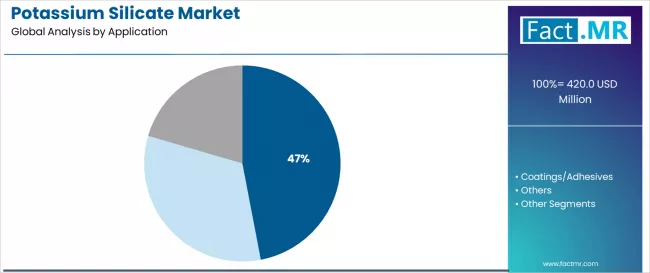
The crop protection & foliar feed segment projects to account for 47.0% of the potassium silicate market in 2025. This reaffirms its position as the leading application category. Agricultural entities utilize crop protection implementations for superior farming standards. Treatment system integrators prefer these systems when operating across diverse agricultural platforms. Excellent sustainability properties attract users. Widespread acceptance ranges from basic crop operations to organic farming processing. Crop protection technology's advanced treatment methods address farmer requirements for efficient agricultural solutions. Complex farming environments benefit from these capabilities.
This application segment forms the foundation of modern sustainable agriculture adoption patterns. The implementation offers greatest operational sustainability. Established market demand exists across multiple agricultural categories. Farming segments show strong adoption. Farmer investments in crop protection standardization continue. Treatment efficiency improvements strengthen adoption among agricultural producers. Farming companies prioritize sustainability with operational efficiency. Crop protection implementations align with functionality preferences. Performance expectations make these systems central components of comprehensive sustainable farming strategies.
By Form, the Liquid Segment Accounts for 72.0% Market Share
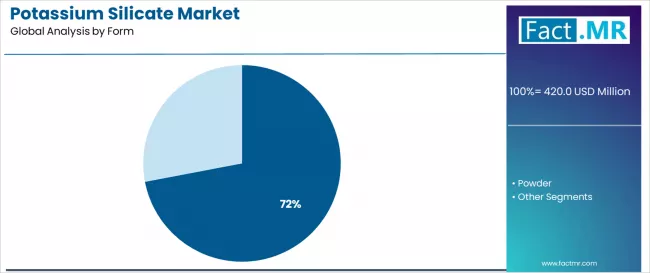
The liquid applications project to represent 72.0% of potassium silicate demand in 2025. This underscores their critical role as primary form for treatment systems. Agricultural operations use these systems across crop applications. Farming operations benefit from application capabilities. Agricultural applications show strong adoption. Farmers prefer liquid form for exceptional handling characteristics. Scalable application options appeal to users. Ability to handle diverse crop demands while ensuring consistent treatment performance attracts adoption. Various farming platforms benefit from application methods. Essential form for modern agricultural operations offers functional advantages. Application benefits remain important considerations.
The segment gains support from continuous innovation in agricultural technologies. Growing availability of specialized implementations enables diverse farming requirements. Enhanced treatment uniformity capabilities expand applications. Extended sustainability capabilities attract investment. Farmers invest in advanced treatment systems supporting large-scale agricultural integration. Operational development drives growth. Agricultural automation trends become prevalent. Farmer sustainability awareness increases acceptance. Liquid applications continue representing major implementation markets. Advanced agricultural utilization strategies gain support. Treatment integration initiatives expand market reach.
By End-Use Sector, the Agriculture Segment Accounts for 55.0% Market Share
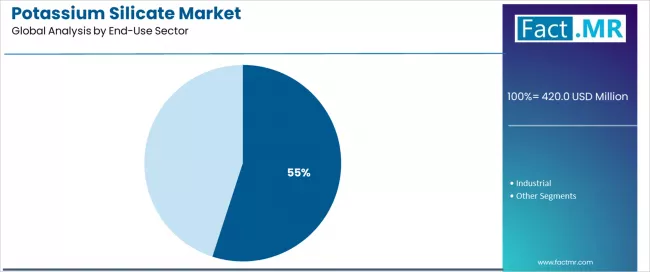
Agriculture applications project to represent 55.0% of potassium silicate demand in 2025. This demonstrates significance as primary deployment sector for treatment systems. Farming operations benefit from sustainability advantages. Agricultural facilities show strong adoption. Agricultural operators utilize potassium silicate for exceptional crop characteristics. Proven reliability in farming environments attracts users. Ability to maintain consistent treatment performance across diverse agricultural conditions appeals to farmers. The segment's dominance reflects critical nature of sustainable treatment in agricultural operations. Industry commitment to organic standards drives adoption.
The agriculture sector drives innovation in treatment technology through demanding farming requirements. Stringent sustainability regulations exist. Farmers invest heavily in advanced treatment systems ensuring crop continuity. Environmental compliance requirements grow. Increasing emphasis on sustainable efficiency supports market position. Organic management initiatives expand. Agriculture applications maintain position as largest end-use segment. Technological advancement initiatives continue. Performance optimization across potassium silicate markets gains momentum.
What are the Drivers, Restraints, and Key Trends of the Potassium Silicate Market?
The potassium silicate market advances steadily due to increasing sustainable agriculture demands driven by organic farming expansion. Agricultural modernization supports growth. Growing adoption of treatment systems provides superior sustainability characteristics. Crop protection benefits enable enhanced agricultural outcomes across diverse farming applications. Industrial applications expand market reach.
The market faces challenges including seasonal demand fluctuations. Complex agricultural requirements create compliance needs. Specialized farming requirements grow. Weather-dependent programs become more sophisticated. Innovation in treatment automation continues influencing product development. Cost-effective production methods drive market expansion patterns.
Expansion of Organic Farming and Sustainable Agriculture
Rising emphasis organic farming sectors enable market development. Advanced sustainability management capabilities expand applications. Agricultural environmental awareness drives manufacturers to produce advanced potassium silicate solutions. Superior sustainability positioning attracts users. Enhanced organic profiles gain acceptance. Seamless integration functionalities expand market reach. Advanced treatment systems provide improved operational outcomes.
More efficient farming workflows develop. Reliable performance across various agricultural applications continues. Operating conditions improve with advanced systems. Developers recognize competitive advantages of sustainability solution integration capabilities. Market differentiation opportunities expand. Environmental positioning becomes increasingly important.
Integration of Precision Agriculture Technologies and Smart Farming
Modern potassium silicate providers incorporate advanced farming technology. Agricultural system integration expands capabilities. Sophisticated treatment solutions enhance product appeal. Intelligent application features develop steadily. Value-added solutions for agricultural customers gain acceptance. These technologies improve farming efficiency. New market opportunities emerge including standardized performance. Optimized treatment enhancement capabilities expand. Enhanced reliability characteristics attract users. Advanced agricultural integration allows developers supporting comprehensive farming technologies. Market expansion beyond traditional treatment approaches continues.
Development of Industrial Coating and Adhesive Applications
Growing adoption of specialty solutions enables market development. Advanced performance management capabilities expand applications. Chemical performance awareness drives manufacturers to produce advanced potassium silicate solutions. Superior processing positioning attracts users. Enhanced application profiles gain acceptance. Seamless integration functionalities expand market reach.
Advanced chemical systems provide improved operational outcomes. More efficient industrial workflows develop. Reliable performance across various industrial applications continues. Operating conditions improve with advanced systems. Developers recognize competitive advantages of specialty solution integration capabilities. Market differentiation opportunities expand. Industrial positioning becomes increasingly important.
Analysis of the Potassium Silicate Market by Key Countries
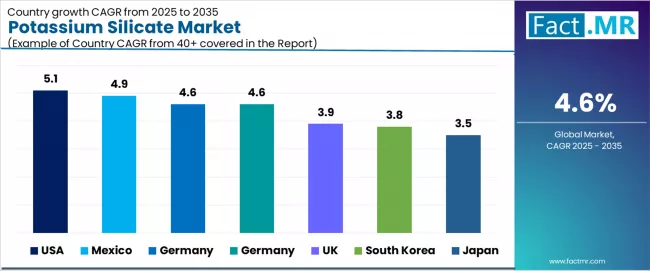
| Country | CAGR (2025-2035) |
|---|---|
| USA | 5.1% |
| Mexico | 4.9% |
| Germany | 4.6% |
| France | 4.6% |
| UK | 3.9% |
| South Korea | 3.8% |
| Japan | 3.5% |
The potassium silicate market experiences solid growth globally. The USA leads at 5.1% CAGR through 2035. Expanding agricultural capacity drives growth. Increasing sustainable farming programs support development. Significant investment in organic agriculture advancement continues. Mexico follows at 4.9%. Increasing agricultural sustainability supports growth. Growing farming modernization patterns develop. Expanding agricultural infrastructure drives demand. Germany shows growth at 4.6%. Engineering leadership emphasizes development. Agricultural technology advancement continues.
France records 4.6% growth. Expanding agricultural capabilities support market development. Sustainable system integration modernization continues. The UK demonstrates 3.9% growth. Advanced agricultural technology development occurs. Organic farming adoption trends drive market expansion. South Korea exhibits 3.8% growth. Agricultural technology innovation emphasizes development. Farming advancement continues. Japan shows 3.5% growth. Quality control initiatives support development. Technology-focused agricultural patterns continue.
The report covers in-depth analysis of 40+ countries. Seven top-performing countries receive highlighting below.
USA Leads Global Market Growth with Agricultural Innovation Excellence
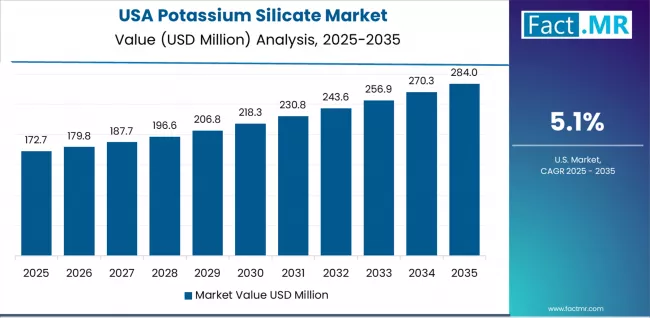
Revenue from potassium silicate in the USA projects solid growth with 5.1% CAGR through 2035. Expanding agricultural capacity drives development. Growing sustainable farming programs receive agricultural initiative support promoting organic development. The country's strong position in agricultural technology supports growth. Increasing investment in treatment infrastructure creates substantial demand for advanced implementations. Major agricultural companies establish comprehensive sustainable capabilities. Treatment system companies serve domestic farming demand. Expanding organic markets drive growth.
The US leads global market growth due to its advanced agricultural sector and strong organic farming adoption. The country benefits from established agricultural infrastructure supporting sustainable production. Major factors include large-scale organic farming creating demand. Strong regulatory support for sustainable agriculture through USDA organic certification. Advanced agricultural research institutions developing treatment technologies. Major agricultural companies driving organic innovation. Growing consumer demand for organic products creating premium pricing. Robust extension services supporting farmer education and technology adoption. Strong supply chain networks supporting agricultural distribution. High-value crops like fruits and vegetables justifying premium treatment solutions.
Agricultural support for sustainable farming modernization initiatives drives demand for advanced treatment systems. Major production regions benefit from development. Agricultural centers across the country show expansion. Strong agricultural technology growth occurs. Expanding network of organic-focused producers supports adoption. Agricultural operators seek advanced treatment capabilities. Integrated sustainable technologies gain acceptance.
Mexico Demonstrates Strong Agricultural Growth with Sustainable Development
Revenue from potassium silicate in Mexico expands at 4.9% CAGR. The country's growing agricultural sector supports development. Expanding sustainable capacity drives growth. Increasing adoption of organic technologies continues. Country initiatives promoting agricultural modernization create demand. Growing environmental awareness drives requirements for quality-controlled treatment systems. International agricultural providers establish extensive capabilities. Domestic farming companies address growing demand for advanced treatment solutions.
Mexico shows strong growth potential driven by agricultural expansion and export market opportunities. The country experiences rapid agricultural development supported by favorable climate conditions. Key factors include growing organic fruit and vegetable exports to North American markets. Expanding avocado and berry production requiring sustainable treatments. Rising consumer demand for organic products in domestic markets. Government support for sustainable agriculture programs. Growing adoption of integrated pest management practices. Strategic position for serving North American organic markets. Increasing focus on sustainable farming practices. Strong agricultural cooperatives adopting advanced treatment technologies.
Rising agricultural requirements create opportunities for potassium silicate adoption. Metropolitan agricultural centers show growth. Progressive farmers invest in modern sustainable facilities. Major agricultural regions expand operations. Growing focus on agricultural sustainability drives adoption. Treatment features appeal to farmers seeking enhanced crop capabilities. Advanced agricultural delivery experiences attract investment.
Germany Demonstrates Agricultural Leadership with Sustainable Innovation
Revenue from potassium silicate in Germany expands at 4.6% CAGR. The country's agricultural heritage supports development. Strong emphasis on sustainable technology continues. Robust demand for advanced treatment systems exists in agricultural applications. Farming applications drive growth. The nation's mature agricultural sector supports development. Technology-focused operations drive sophisticated implementations throughout the agricultural industry. Leading manufacturers invest extensively in technology development. Advanced treatment methods serve domestic markets. International markets benefit from German expertise.
Germany maintains its position as Europe's sustainable agriculture leader with strong environmental policies. The country's advanced agricultural sector drives organic farming adoption. Growth drivers include strict EU organic regulations requiring sustainable treatments. Strong research institutions developing agricultural technologies. Advanced precision farming techniques requiring specialized treatments. Excellent agricultural education producing technical expertise. High R&D investment in agricultural technologies. Strong environmental regulations encouraging sustainable farming solutions. Advanced automation in agricultural processing facilities. Well-developed supply chain for organic agricultural products.
Rising demand for high-performance treatment technologies creates requirements for sophisticated solutions. Exceptional treatment capabilities appeal to quality-conscious farmers. Enhanced agricultural experiences gain acceptance. Advanced treatment methods attract investment. Strong agricultural tradition supports growth. Growing investment in treatment technologies drives adoption. Quality platforms with advanced development methods appeal to users. Enhanced treatment profiles across farming operations expand in major agricultural regions.
France Focuses on Agricultural Modernization and Organic Integration
Revenue from potassium silicate in France grows at 4.6% CAGR. The country's agricultural modernization sector drives development. Growing organic integration programs support expansion. Increasing investment in sustainable development continues. France's agricultural infrastructure supports market growth. Commitment to technological advancement drives demand for diverse treatment solutions. Multiple agricultural segments benefit from development. Farmers establish comprehensive organic capabilities. Growing domestic market drives development. Expanding agricultural opportunities support growth.
France demonstrates steady growth supported by diverse agricultural base and organic expertise. Key factors include strong wine industry requiring sustainable treatment solutions. Advanced organic farming sector with government support. Strategic position in European organic supply chains. Growing focus on sustainable viticulture and crop protection. Strong agricultural research institutions developing treatment technologies. Increasing emphasis on organic agricultural production. Strong food processing sectors requiring organic raw materials. Growing adoption of integrated farming systems. Well-developed organic certification and distribution networks.
Strong agricultural expansion drives adoption of integrated treatment systems. Superior treatment capabilities appeal to users. Advanced integration attracts large agricultural operators. Progressive farming companies invest in systems. Growing treatment diversity supports market expansion. Increasing agricultural adoption drives advanced implementations. Seamless treatment profiles appeal to users. Modern agricultural delivery throughout the country's farming regions gains acceptance.
UK Emphasizes Sustainable Agriculture and Organic Development
Revenue from potassium silicate in the UK expands at 3.9% CAGR. The country's advanced agricultural technology sector supports development. Strategic focus on sustainable solutions continues. Established farming capabilities drive growth. The UK's agricultural innovation leadership supports market expansion. Sustainable technology integration drives demand for specialized implementations in agricultural applications. Farming operations show growth. Advanced organic products expand market reach. Operators invest in comprehensive agricultural development serving domestic specialty markets. International quality applications benefit from development.
The UK shows consistent growth driven by sustainable agriculture initiatives and organic farming expansion. Strong agricultural sector with focus on sustainable practices. Key factors include government support for environmental stewardship programs. Growing organic food market requiring sustainable agricultural inputs. Strong research institutions developing agricultural technologies. Post-Brexit focus on improving domestic agricultural self-sufficiency. Advanced agricultural technology companies developing treatment solutions. Focus on sustainable farming and environmental protection. Strong position in organic product exports. Growing emphasis on agricultural competitiveness through sustainable practices.
Agricultural optimization and treatment technology advancement create opportunities for specialized treatment adoption in advanced systems. Farming services benefit from development. Technology-focused agricultural operations among leading enterprises gain acceptance. Growing emphasis on advanced treatment delivery drives adoption. Treatment features support quality implementations with enhanced technology profiles. Integrated treatment management throughout the country's agricultural technology sector expands market reach.
South Korea Demonstrates Technology Integration and Agricultural Growth
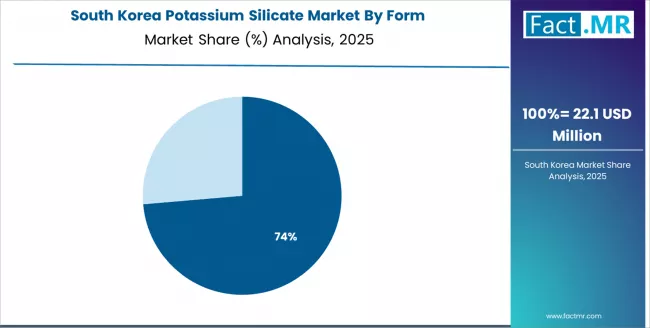
Revenue from potassium silicate in South Korea grows at 3.8% CAGR. The country's technology integration initiatives drive development. Expanding agricultural sector supports growth. Strategic focus on agricultural development continues. South Korea's advanced technology capabilities support market expansion. Commitment to agricultural modernization drives investment in specialized technologies. Major agricultural regions benefit from development. Industry leaders establish comprehensive technology integration systems. Domestic agricultural operations benefit from advanced treatment applications.
South Korea exhibits solid growth driven by precision agriculture and technology adoption. Key drivers include government support for smart farming initiatives. Advanced greenhouse and controlled environment agriculture requiring specialized treatments. Growing organic food market driven by health-conscious consumers. Strong technology companies applying IoT and AI to agriculture. High-value crop production like ginseng and specialty vegetables. Advanced agricultural research institutions developing treatment technologies. Growing export opportunities for high-quality agricultural products. Strong adoption of precision farming technologies. Government programs supporting sustainable agriculture development.
Innovations in agricultural platforms create demand for advanced implementations. Technology integration capabilities attract users. Exceptional treatment properties appeal to progressive agricultural operators. Enhanced technology differentiation gains acceptance. Operational appeal drives adoption. Growing agricultural adoption supports market development. Increasing focus on agricultural innovation drives advanced platform adoption. Integrated treatment delivery gains acceptance. Agricultural optimization across farming enterprises throughout the country expands market reach.
Japan Shows Quality Control Focus and Technology-Driven Production
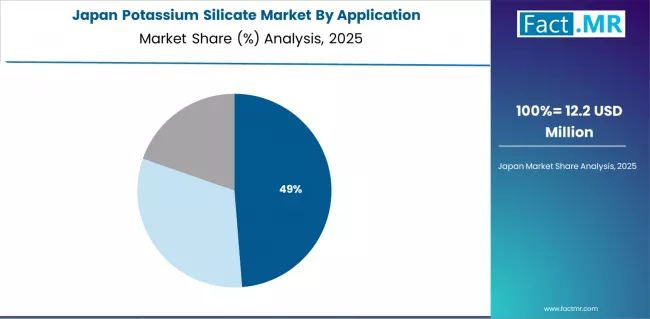
Revenue from potassium silicate in Japan expands at 3.5% CAGR. The country's agricultural system excellence initiatives support development. Growing agricultural technology sector continues expansion. Strategic emphasis on advanced farming development drives market growth. Japan's advanced quality control capabilities support demand. Integrated treatment systems drive demand for high-quality platforms in agricultural operations. Farming applications grow. Advanced technology applications expand market reach. Leading manufacturers invest in specialized capabilities. Technology-focused agricultural requirements gain attention. Treatment industries demand sophisticated solutions.
Japan shows steady growth supported by precision agriculture and quality-focused farming culture. Growth factors include highly sophisticated agricultural industry with strict quality standards. Strong emphasis on quality control and food safety in agricultural production. Advanced greenhouse technology requiring specialized plant treatments. Growing organic and sustainable farming practices. Focus on high-value agricultural products requiring premium treatments. High technology adoption in agricultural processes including precision farming. Strong agricultural research capabilities and innovation. Advanced environmental regulations encouraging sustainable farming. Growing focus on agricultural productivity and efficiency through technology.
Europe Market Split by Country
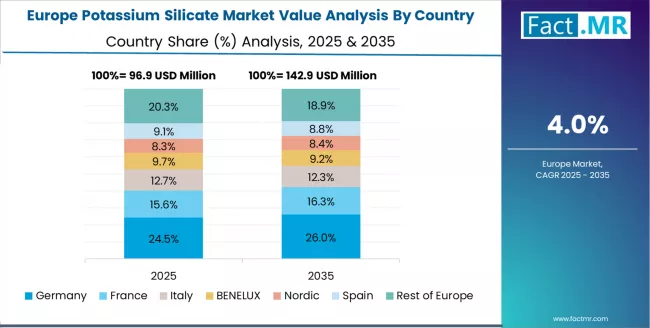
The potassium silicate market in Europe projects growth from USD 126.0 million in 2025 to USD 198.0 million by 2035. This registers CAGR of 4.6% over the forecast period. Germany expects to maintain leadership position with 31.0% market share in 2025. This declines slightly to 30.8% by 2035. Support comes from strong agricultural culture. Sophisticated treatment capabilities continue. Comprehensive agricultural sector serves diverse applications across Europe.
France follows with 24.6% share in 2025. This projects to reach 24.8% by 2035. Robust demand for advanced treatment technologies in agricultural applications drives growth. Sustainable modernization programs support development. Treatment markets benefit from established agricultural infrastructure. Technology integration expertise continues. The UK holds 20.6% share in 2025. This expects to reach 20.8% by 2035. Strong treatment technology sector supports growth. Growing agricultural activities drive development. Italy commands 13.5% share in 2025. This projects to reach 13.7% by 2035. Spain accounts for 8.3% in 2025. This expects to reach 8.4% by 2035. Rest of Europe region anticipates maintaining momentum. Collective share moves from 2.0% to 1.5% by 2035. Increasing treatment modernization in Eastern Europe drives development. Growing technology penetration in Nordic countries implementing advanced agricultural programs supports expansion.
Competitive Landscape of the Potassium Silicate Market
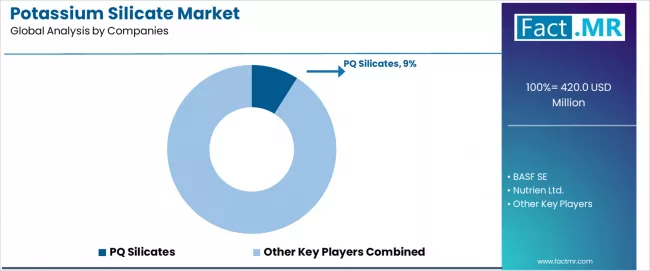
The potassium silicate market demonstrates moderate competition among established agricultural chemical manufacturers, specialized chemical developers, and integrated agricultural solution providers. Companies invest in treatment technology research, quality optimization, advanced manufacturing system development, and comprehensive agricultural capabilities to deliver consistent, high-quality, and cost-competitive potassium silicate solutions. Innovation in advanced processing methods, formulation enhancement, and integrated agricultural applications remains central to strengthening market position and competitive advantage across global markets.
PQ Silicates leads the market with a substantial 9.0% market share, offering comprehensive agricultural solutions including quality treatment platforms and advanced chemical systems with particular focus on crop protection and foliar feeding applications. The company's strength lies in silicate chemical innovation, providing solutions that combine agricultural expertise with advanced technology. BASF provides specialized agricultural capabilities with strong emphasis on advanced potassium silicate implementations and sustainable solutions, particularly serving agricultural and industrial markets. PotashCorp delivers comprehensive agricultural services with focus on nutrient platforms and large-scale farming applications, combining fertilizer expertise with treatment capabilities.
PQ Corporation specializes in advanced chemical devices and specialty implementations for industrial applications, expanding market reach through comprehensive chemical solutions. AkzoNobel focuses on chemical integration and innovative technology solutions for industrial markets. Nouryon offers advanced chemical platforms with emphasis on specialty applications and high-performance chemicals, serving both agricultural and industrial sectors. The competitive environment also includes significant players like Novaphene, Evonik, Nippon Chemical, and Sibelco, each focusing on specific market segments and technological specializations in chemical manufacturing and agricultural applications.
The competitive landscape reflects steady consolidation as larger chemical companies acquire specialized potassium silicate manufacturers to expand their product portfolios and market reach. Companies focus on developing integrated solutions that combine potassium silicate technology with advanced application systems, quality control capabilities, and specialized agricultural support to differentiate offerings and capture higher-value market segments. Strategic partnerships between chemical manufacturers and agricultural distributors drive innovation and application development, while increasing emphasis on sustainability and organic certification creates opportunities for technology leaders to develop environmentally friendly solutions.
Key Players in the Potassium Silicate Market
- PQ Silicates
- BASF SE
- Nutrien Ltd.
- AkzoNobel N.V.
- Nouryon B.V.
- Novaphene Specialities Pvt. Ltd.
- Evonik Industries AG
- Nippon Chemical Industrial Co., Ltd.
- Sibelco N.V.
Scope of the Report
| Item | Value |
|---|---|
| Quantitative Units | USD 420.0 Million |
| Application | Crop protection & foliar feed; Coatings/adhesives; Others |
| Form | Liquid; Powder |
| End-Use Sector | Agriculture; Industrial |
| Regions Covered | North America; Europe; Asia-Pacific; Latin America; Middle East & Africa |
| Countries Covered | USA; Germany; France; UK; Japan; South Korea; Mexico; and 40+ additional countries |
| Key Companies Profiled | PQ Silicates; BASF; Nutrien; PQ Corporation; AkzoNobel; Nouryon |
| Additional Attributes | Dollar sales by application and form category; regional demand trends; competitive landscape; technological advancements in agricultural engineering; advanced treatment development; sustainability innovation; agricultural integration protocols |
Potassium Silicate Market by Segments
-
Application :
- Crop Protection & Foliar Feed
- Coatings/Adhesives
- Others
-
Form :
- Liquid
- Powder
-
End-Use Sector :
- Agriculture
- Industrial
-
Region :
- North America
- USA
- Canada
- Mexico
- Europe
- Germany
- UK
- France
- Italy
- Spain
- Rest of Europe
- Asia-Pacific
- China
- Japan
- South Korea
- India
- Australia
- Rest of Asia-Pacific
- Latin America
- Brazil
- Argentina
- Rest of Latin America
- Middle East & Africa
- Saudi Arabia
- UAE
- South Africa
- Rest of Middle East & Africa
- North America
Table of Content
- Executive Summary
- Global Market Outlook
- Demand to side Trends
- Supply to side Trends
- Technology Roadmap Analysis
- Analysis and Recommendations
- Market Overview
- Market Coverage / Taxonomy
- Market Definition / Scope / Limitations
- Market Background
- Market Dynamics
- Drivers
- Restraints
- Opportunity
- Trends
- Scenario Forecast
- Demand in Optimistic Scenario
- Demand in Likely Scenario
- Demand in Conservative Scenario
- Opportunity Map Analysis
- Product Life Cycle Analysis
- Supply Chain Analysis
- Investment Feasibility Matrix
- Value Chain Analysis
- PESTLE and Porter’s Analysis
- Regulatory Landscape
- Regional Parent Market Outlook
- Production and Consumption Statistics
- Import and Export Statistics
- Market Dynamics
- Global Market Analysis 2020 to 2024 and Forecast, 2025 to 2035
- Historical Market Size Value (USD Million) Analysis, 2020 to 2024
- Current and Future Market Size Value (USD Million) Projections, 2025 to 2035
- Y to o to Y Growth Trend Analysis
- Absolute $ Opportunity Analysis
- Global Market Pricing Analysis 2020 to 2024 and Forecast 2025 to 2035
- Global Market Analysis 2020 to 2024 and Forecast 2025 to 2035, By Application
- Introduction / Key Findings
- Historical Market Size Value (USD Million) Analysis By Application , 2020 to 2024
- Current and Future Market Size Value (USD Million) Analysis and Forecast By Application , 2025 to 2035
- Crop Protection & Foliar Feed
- Coatings/Adhesives
- Others
- Y to o to Y Growth Trend Analysis By Application , 2020 to 2024
- Absolute $ Opportunity Analysis By Application , 2025 to 2035
- Global Market Analysis 2020 to 2024 and Forecast 2025 to 2035, By Form
- Introduction / Key Findings
- Historical Market Size Value (USD Million) Analysis By Form, 2020 to 2024
- Current and Future Market Size Value (USD Million) Analysis and Forecast By Form, 2025 to 2035
- Liquid
- Powder
- Y to o to Y Growth Trend Analysis By Form, 2020 to 2024
- Absolute $ Opportunity Analysis By Form, 2025 to 2035
- Global Market Analysis 2020 to 2024 and Forecast 2025 to 2035, By End-Use Sector
- Introduction / Key Findings
- Historical Market Size Value (USD Million) Analysis By End-Use Sector, 2020 to 2024
- Current and Future Market Size Value (USD Million) Analysis and Forecast By End-Use Sector, 2025 to 2035
- Agriculture
- Industrial
- Y to o to Y Growth Trend Analysis By End-Use Sector, 2020 to 2024
- Absolute $ Opportunity Analysis By End-Use Sector, 2025 to 2035
- Global Market Analysis 2020 to 2024 and Forecast 2025 to 2035, By Region
- Introduction
- Historical Market Size Value (USD Million) Analysis By Region, 2020 to 2024
- Current Market Size Value (USD Million) Analysis and Forecast By Region, 2025 to 2035
- North America
- Latin America
- Western Europe
- Eastern Europe
- East Asia
- South Asia and Pacific
- Middle East & Africa
- Market Attractiveness Analysis By Region
- North America Market Analysis 2020 to 2024 and Forecast 2025 to 2035, By Country
- Historical Market Size Value (USD Million) Trend Analysis By Market Taxonomy, 2020 to 2024
- Market Size Value (USD Million) Forecast By Market Taxonomy, 2025 to 2035
- By Country
- USA
- Canada
- Mexico
- By Application
- By Form
- By End-Use Sector
- By Country
- Market Attractiveness Analysis
- By Country
- By Application
- By Form
- By End-Use Sector
- Key Takeaways
- Latin America Market Analysis 2020 to 2024 and Forecast 2025 to 2035, By Country
- Historical Market Size Value (USD Million) Trend Analysis By Market Taxonomy, 2020 to 2024
- Market Size Value (USD Million) Forecast By Market Taxonomy, 2025 to 2035
- By Country
- Brazil
- Chile
- Rest of Latin America
- By Application
- By Form
- By End-Use Sector
- By Country
- Market Attractiveness Analysis
- By Country
- By Application
- By Form
- By End-Use Sector
- Key Takeaways
- Western Europe Market Analysis 2020 to 2024 and Forecast 2025 to 2035, By Country
- Historical Market Size Value (USD Million) Trend Analysis By Market Taxonomy, 2020 to 2024
- Market Size Value (USD Million) Forecast By Market Taxonomy, 2025 to 2035
- By Country
- Germany
- UK
- Italy
- Spain
- France
- Nordic
- BENELUX
- Rest of Western Europe
- By Application
- By Form
- By End-Use Sector
- By Country
- Market Attractiveness Analysis
- By Country
- By Application
- By Form
- By End-Use Sector
- Key Takeaways
- Eastern Europe Market Analysis 2020 to 2024 and Forecast 2025 to 2035, By Country
- Historical Market Size Value (USD Million) Trend Analysis By Market Taxonomy, 2020 to 2024
- Market Size Value (USD Million) Forecast By Market Taxonomy, 2025 to 2035
- By Country
- Russia
- Poland
- Hungary
- Balkan & Baltic
- Rest of Eastern Europe
- By Application
- By Form
- By End-Use Sector
- By Country
- Market Attractiveness Analysis
- By Country
- By Application
- By Form
- By End-Use Sector
- Key Takeaways
- East Asia Market Analysis 2020 to 2024 and Forecast 2025 to 2035, By Country
- Historical Market Size Value (USD Million) Trend Analysis By Market Taxonomy, 2020 to 2024
- Market Size Value (USD Million) Forecast By Market Taxonomy, 2025 to 2035
- By Country
- China
- Japan
- South Korea
- By Application
- By Form
- By End-Use Sector
- By Country
- Market Attractiveness Analysis
- By Country
- By Application
- By Form
- By End-Use Sector
- Key Takeaways
- South Asia and Pacific Market Analysis 2020 to 2024 and Forecast 2025 to 2035, By Country
- Historical Market Size Value (USD Million) Trend Analysis By Market Taxonomy, 2020 to 2024
- Market Size Value (USD Million) Forecast By Market Taxonomy, 2025 to 2035
- By Country
- India
- ASEAN
- Australia & New Zealand
- Rest of South Asia and Pacific
- By Application
- By Form
- By End-Use Sector
- By Country
- Market Attractiveness Analysis
- By Country
- By Application
- By Form
- By End-Use Sector
- Key Takeaways
- Middle East & Africa Market Analysis 2020 to 2024 and Forecast 2025 to 2035, By Country
- Historical Market Size Value (USD Million) Trend Analysis By Market Taxonomy, 2020 to 2024
- Market Size Value (USD Million) Forecast By Market Taxonomy, 2025 to 2035
- By Country
- Kingdom of Saudi Arabia
- Other GCC Countries
- Turkiye
- South Africa
- Other African Union
- Rest of Middle East & Africa
- By Application
- By Form
- By End-Use Sector
- By Country
- Market Attractiveness Analysis
- By Country
- By Application
- By Form
- By End-Use Sector
- Key Takeaways
- Key Countries Market Analysis
- USA
- Pricing Analysis
- Market Share Analysis, 2024
- By Application
- By Form
- By End-Use Sector
- Canada
- Pricing Analysis
- Market Share Analysis, 2024
- By Application
- By Form
- By End-Use Sector
- Mexico
- Pricing Analysis
- Market Share Analysis, 2024
- By Application
- By Form
- By End-Use Sector
- Brazil
- Pricing Analysis
- Market Share Analysis, 2024
- By Application
- By Form
- By End-Use Sector
- Chile
- Pricing Analysis
- Market Share Analysis, 2024
- By Application
- By Form
- By End-Use Sector
- Germany
- Pricing Analysis
- Market Share Analysis, 2024
- By Application
- By Form
- By End-Use Sector
- UK
- Pricing Analysis
- Market Share Analysis, 2024
- By Application
- By Form
- By End-Use Sector
- Italy
- Pricing Analysis
- Market Share Analysis, 2024
- By Application
- By Form
- By End-Use Sector
- Spain
- Pricing Analysis
- Market Share Analysis, 2024
- By Application
- By Form
- By End-Use Sector
- France
- Pricing Analysis
- Market Share Analysis, 2024
- By Application
- By Form
- By End-Use Sector
- India
- Pricing Analysis
- Market Share Analysis, 2024
- By Application
- By Form
- By End-Use Sector
- ASEAN
- Pricing Analysis
- Market Share Analysis, 2024
- By Application
- By Form
- By End-Use Sector
- Australia & New Zealand
- Pricing Analysis
- Market Share Analysis, 2024
- By Application
- By Form
- By End-Use Sector
- China
- Pricing Analysis
- Market Share Analysis, 2024
- By Application
- By Form
- By End-Use Sector
- Japan
- Pricing Analysis
- Market Share Analysis, 2024
- By Application
- By Form
- By End-Use Sector
- South Korea
- Pricing Analysis
- Market Share Analysis, 2024
- By Application
- By Form
- By End-Use Sector
- Russia
- Pricing Analysis
- Market Share Analysis, 2024
- By Application
- By Form
- By End-Use Sector
- Poland
- Pricing Analysis
- Market Share Analysis, 2024
- By Application
- By Form
- By End-Use Sector
- Hungary
- Pricing Analysis
- Market Share Analysis, 2024
- By Application
- By Form
- By End-Use Sector
- Kingdom of Saudi Arabia
- Pricing Analysis
- Market Share Analysis, 2024
- By Application
- By Form
- By End-Use Sector
- Turkiye
- Pricing Analysis
- Market Share Analysis, 2024
- By Application
- By Form
- By End-Use Sector
- South Africa
- Pricing Analysis
- Market Share Analysis, 2024
- By Application
- By Form
- By End-Use Sector
- USA
- Market Structure Analysis
- Competition Dashboard
- Competition Benchmarking
- Market Share Analysis of Top Players
- By Regional
- By Application
- By Form
- By End-Use Sector
- Competition Analysis
- Competition Deep Dive
- PQ Silicates
- Overview
- Product Portfolio
- Profitability by Market Segments (Product/Age /Sales Channel/Region)
- Sales Footprint
- Strategy Overview
- Marketing Strategy
- Product Strategy
- Channel Strategy
- BASF SE
- Nutrien Ltd.
- AkzoNobel N.V.
- Nouryon B.V.
- Novaphene Specialities Pvt. Ltd.
- Evonik Industries AG
- Nippon Chemical Industrial Co., Ltd.
- Sibelco N.V.
- PQ Silicates
- Competition Deep Dive
- Assumptions & Acronyms Used
- Research Methodology
List Of Table
- Table 1: Global Market Value (USD Million) Forecast by Region, 2020 to 2035
- Table 2: Global Market Value (USD Million) Forecast by Application , 2020 to 2035
- Table 3: Global Market Value (USD Million) Forecast by Form, 2020 to 2035
- Table 4: Global Market Value (USD Million) Forecast by End-Use Sector, 2020 to 2035
- Table 5: North America Market Value (USD Million) Forecast by Country, 2020 to 2035
- Table 6: North America Market Value (USD Million) Forecast by Application , 2020 to 2035
- Table 7: North America Market Value (USD Million) Forecast by Form, 2020 to 2035
- Table 8: North America Market Value (USD Million) Forecast by End-Use Sector, 2020 to 2035
- Table 9: Latin America Market Value (USD Million) Forecast by Country, 2020 to 2035
- Table 10: Latin America Market Value (USD Million) Forecast by Application , 2020 to 2035
- Table 11: Latin America Market Value (USD Million) Forecast by Form, 2020 to 2035
- Table 12: Latin America Market Value (USD Million) Forecast by End-Use Sector, 2020 to 2035
- Table 13: Western Europe Market Value (USD Million) Forecast by Country, 2020 to 2035
- Table 14: Western Europe Market Value (USD Million) Forecast by Application , 2020 to 2035
- Table 15: Western Europe Market Value (USD Million) Forecast by Form, 2020 to 2035
- Table 16: Western Europe Market Value (USD Million) Forecast by End-Use Sector, 2020 to 2035
- Table 17: Eastern Europe Market Value (USD Million) Forecast by Country, 2020 to 2035
- Table 18: Eastern Europe Market Value (USD Million) Forecast by Application , 2020 to 2035
- Table 19: Eastern Europe Market Value (USD Million) Forecast by Form, 2020 to 2035
- Table 20: Eastern Europe Market Value (USD Million) Forecast by End-Use Sector, 2020 to 2035
- Table 21: East Asia Market Value (USD Million) Forecast by Country, 2020 to 2035
- Table 22: East Asia Market Value (USD Million) Forecast by Application , 2020 to 2035
- Table 23: East Asia Market Value (USD Million) Forecast by Form, 2020 to 2035
- Table 24: East Asia Market Value (USD Million) Forecast by End-Use Sector, 2020 to 2035
- Table 25: South Asia and Pacific Market Value (USD Million) Forecast by Country, 2020 to 2035
- Table 26: South Asia and Pacific Market Value (USD Million) Forecast by Application , 2020 to 2035
- Table 27: South Asia and Pacific Market Value (USD Million) Forecast by Form, 2020 to 2035
- Table 28: South Asia and Pacific Market Value (USD Million) Forecast by End-Use Sector, 2020 to 2035
- Table 29: Middle East & Africa Market Value (USD Million) Forecast by Country, 2020 to 2035
- Table 30: Middle East & Africa Market Value (USD Million) Forecast by Application , 2020 to 2035
- Table 31: Middle East & Africa Market Value (USD Million) Forecast by Form, 2020 to 2035
- Table 32: Middle East & Africa Market Value (USD Million) Forecast by End-Use Sector, 2020 to 2035
List Of Figures
- Figure 1: Global Market Pricing Analysis
- Figure 2: Global Market Value (USD Million) Forecast 2020-2035
- Figure 3: Global Market Value Share and BPS Analysis by Application , 2025 and 2035
- Figure 4: Global Market Y to o to Y Growth Comparison by Application , 2025-2035
- Figure 5: Global Market Attractiveness Analysis by Application
- Figure 6: Global Market Value Share and BPS Analysis by Form, 2025 and 2035
- Figure 7: Global Market Y to o to Y Growth Comparison by Form, 2025-2035
- Figure 8: Global Market Attractiveness Analysis by Form
- Figure 9: Global Market Value Share and BPS Analysis by End-Use Sector, 2025 and 2035
- Figure 10: Global Market Y to o to Y Growth Comparison by End-Use Sector, 2025-2035
- Figure 11: Global Market Attractiveness Analysis by End-Use Sector
- Figure 12: Global Market Value (USD Million) Share and BPS Analysis by Region, 2025 and 2035
- Figure 13: Global Market Y to o to Y Growth Comparison by Region, 2025-2035
- Figure 14: Global Market Attractiveness Analysis by Region
- Figure 15: North America Market Incremental Dollar Opportunity, 2025-2035
- Figure 16: Latin America Market Incremental Dollar Opportunity, 2025-2035
- Figure 17: Western Europe Market Incremental Dollar Opportunity, 2025-2035
- Figure 18: Eastern Europe Market Incremental Dollar Opportunity, 2025-2035
- Figure 19: East Asia Market Incremental Dollar Opportunity, 2025-2035
- Figure 20: South Asia and Pacific Market Incremental Dollar Opportunity, 2025-2035
- Figure 21: Middle East & Africa Market Incremental Dollar Opportunity, 2025-2035
- Figure 22: North America Market Value Share and BPS Analysis by Country, 2025 and 2035
- Figure 23: North America Market Value Share and BPS Analysis by Application , 2025 and 2035
- Figure 24: North America Market Y to o to Y Growth Comparison by Application , 2025-2035
- Figure 25: North America Market Attractiveness Analysis by Application
- Figure 26: North America Market Value Share and BPS Analysis by Form, 2025 and 2035
- Figure 27: North America Market Y to o to Y Growth Comparison by Form, 2025-2035
- Figure 28: North America Market Attractiveness Analysis by Form
- Figure 29: North America Market Value Share and BPS Analysis by End-Use Sector, 2025 and 2035
- Figure 30: North America Market Y to o to Y Growth Comparison by End-Use Sector, 2025-2035
- Figure 31: North America Market Attractiveness Analysis by End-Use Sector
- Figure 32: Latin America Market Value Share and BPS Analysis by Country, 2025 and 2035
- Figure 33: Latin America Market Value Share and BPS Analysis by Application , 2025 and 2035
- Figure 34: Latin America Market Y to o to Y Growth Comparison by Application , 2025-2035
- Figure 35: Latin America Market Attractiveness Analysis by Application
- Figure 36: Latin America Market Value Share and BPS Analysis by Form, 2025 and 2035
- Figure 37: Latin America Market Y to o to Y Growth Comparison by Form, 2025-2035
- Figure 38: Latin America Market Attractiveness Analysis by Form
- Figure 39: Latin America Market Value Share and BPS Analysis by End-Use Sector, 2025 and 2035
- Figure 40: Latin America Market Y to o to Y Growth Comparison by End-Use Sector, 2025-2035
- Figure 41: Latin America Market Attractiveness Analysis by End-Use Sector
- Figure 42: Western Europe Market Value Share and BPS Analysis by Country, 2025 and 2035
- Figure 43: Western Europe Market Value Share and BPS Analysis by Application , 2025 and 2035
- Figure 44: Western Europe Market Y to o to Y Growth Comparison by Application , 2025-2035
- Figure 45: Western Europe Market Attractiveness Analysis by Application
- Figure 46: Western Europe Market Value Share and BPS Analysis by Form, 2025 and 2035
- Figure 47: Western Europe Market Y to o to Y Growth Comparison by Form, 2025-2035
- Figure 48: Western Europe Market Attractiveness Analysis by Form
- Figure 49: Western Europe Market Value Share and BPS Analysis by End-Use Sector, 2025 and 2035
- Figure 50: Western Europe Market Y to o to Y Growth Comparison by End-Use Sector, 2025-2035
- Figure 51: Western Europe Market Attractiveness Analysis by End-Use Sector
- Figure 52: Eastern Europe Market Value Share and BPS Analysis by Country, 2025 and 2035
- Figure 53: Eastern Europe Market Value Share and BPS Analysis by Application , 2025 and 2035
- Figure 54: Eastern Europe Market Y to o to Y Growth Comparison by Application , 2025-2035
- Figure 55: Eastern Europe Market Attractiveness Analysis by Application
- Figure 56: Eastern Europe Market Value Share and BPS Analysis by Form, 2025 and 2035
- Figure 57: Eastern Europe Market Y to o to Y Growth Comparison by Form, 2025-2035
- Figure 58: Eastern Europe Market Attractiveness Analysis by Form
- Figure 59: Eastern Europe Market Value Share and BPS Analysis by End-Use Sector, 2025 and 2035
- Figure 60: Eastern Europe Market Y to o to Y Growth Comparison by End-Use Sector, 2025-2035
- Figure 61: Eastern Europe Market Attractiveness Analysis by End-Use Sector
- Figure 62: East Asia Market Value Share and BPS Analysis by Country, 2025 and 2035
- Figure 63: East Asia Market Value Share and BPS Analysis by Application , 2025 and 2035
- Figure 64: East Asia Market Y to o to Y Growth Comparison by Application , 2025-2035
- Figure 65: East Asia Market Attractiveness Analysis by Application
- Figure 66: East Asia Market Value Share and BPS Analysis by Form, 2025 and 2035
- Figure 67: East Asia Market Y to o to Y Growth Comparison by Form, 2025-2035
- Figure 68: East Asia Market Attractiveness Analysis by Form
- Figure 69: East Asia Market Value Share and BPS Analysis by End-Use Sector, 2025 and 2035
- Figure 70: East Asia Market Y to o to Y Growth Comparison by End-Use Sector, 2025-2035
- Figure 71: East Asia Market Attractiveness Analysis by End-Use Sector
- Figure 72: South Asia and Pacific Market Value Share and BPS Analysis by Country, 2025 and 2035
- Figure 73: South Asia and Pacific Market Value Share and BPS Analysis by Application , 2025 and 2035
- Figure 74: South Asia and Pacific Market Y to o to Y Growth Comparison by Application , 2025-2035
- Figure 75: South Asia and Pacific Market Attractiveness Analysis by Application
- Figure 76: South Asia and Pacific Market Value Share and BPS Analysis by Form, 2025 and 2035
- Figure 77: South Asia and Pacific Market Y to o to Y Growth Comparison by Form, 2025-2035
- Figure 78: South Asia and Pacific Market Attractiveness Analysis by Form
- Figure 79: South Asia and Pacific Market Value Share and BPS Analysis by End-Use Sector, 2025 and 2035
- Figure 80: South Asia and Pacific Market Y to o to Y Growth Comparison by End-Use Sector, 2025-2035
- Figure 81: South Asia and Pacific Market Attractiveness Analysis by End-Use Sector
- Figure 82: Middle East & Africa Market Value Share and BPS Analysis by Country, 2025 and 2035
- Figure 83: Middle East & Africa Market Value Share and BPS Analysis by Application , 2025 and 2035
- Figure 84: Middle East & Africa Market Y to o to Y Growth Comparison by Application , 2025-2035
- Figure 85: Middle East & Africa Market Attractiveness Analysis by Application
- Figure 86: Middle East & Africa Market Value Share and BPS Analysis by Form, 2025 and 2035
- Figure 87: Middle East & Africa Market Y to o to Y Growth Comparison by Form, 2025-2035
- Figure 88: Middle East & Africa Market Attractiveness Analysis by Form
- Figure 89: Middle East & Africa Market Value Share and BPS Analysis by End-Use Sector, 2025 and 2035
- Figure 90: Middle East & Africa Market Y to o to Y Growth Comparison by End-Use Sector, 2025-2035
- Figure 91: Middle East & Africa Market Attractiveness Analysis by End-Use Sector
- Figure 92: Global Market - Tier Structure Analysis
- Figure 93: Global Market - Company Share Analysis
- FAQs -
How big is the potassium silicate market in 2025?
The global potassium silicate market is estimated to be valued at USD 420.0 million in 2025.
What will be the size of potassium silicate market in 2035?
The market size for the potassium silicate market is projected to reach USD 660.0 million by 2035.
How much will be the potassium silicate market growth between 2025 and 2035?
The potassium silicate market is expected to grow at a 4.6% CAGR between 2025 and 2035.
What are the key product types in the potassium silicate market?
The key product types in potassium silicate market are crop protection & foliar feed, coatings/adhesives and others.
Which form segment to contribute significant share in the potassium silicate market in 2025?
In terms of form, liquid segment to command 72.0% share in the potassium silicate market in 2025.